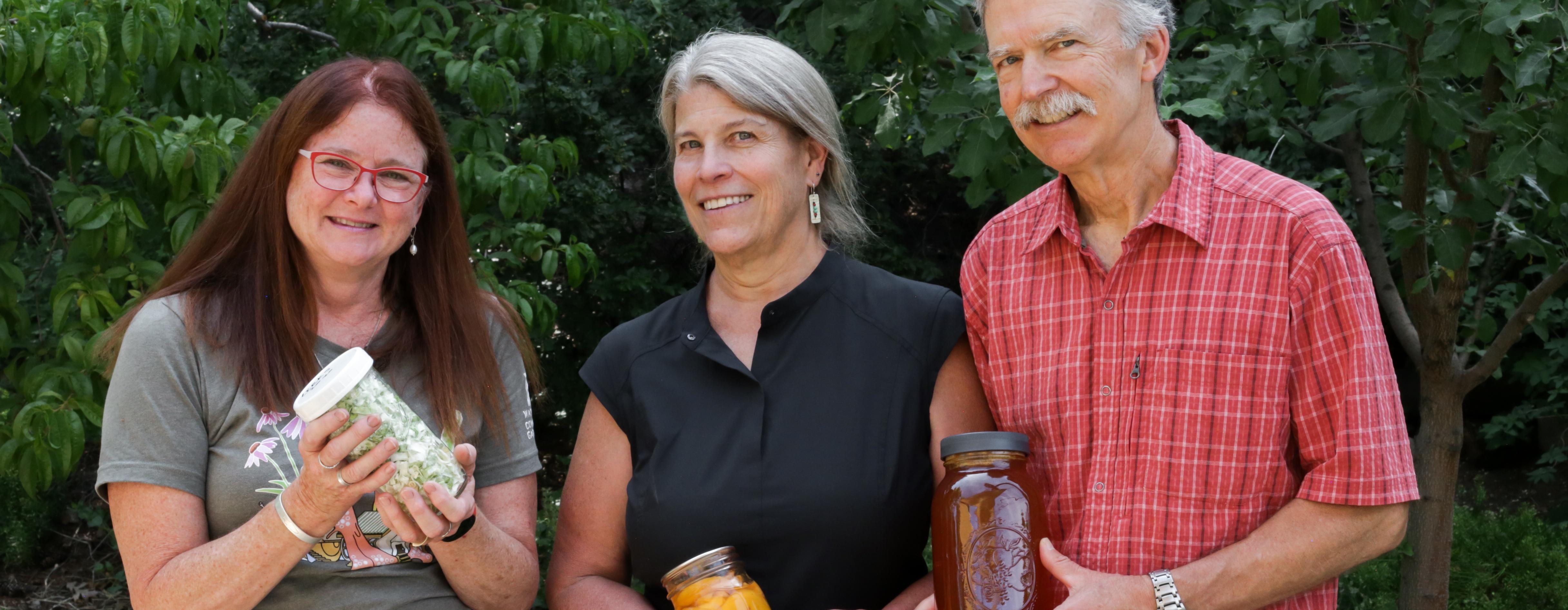We are thrilled to be partnering again this year with Wasatch Community Gardens for a virtual version of their Urban Garden and Farm Tour. In this special series of videos, we’ll be showcasing some creative, experimental and downright beautiful urban gardens and farms in the Salt Lake City community. Come with us, as we take a virtual peek over the fence into our neighbors’ backyards!
Year-Round Food Production
Growing food year-round is a goal for many gardeners, and can be achieved with practice and patience. In this first episode of the 2021 Urban Garden and Farm Tour, we're learning from Lori and Dave about year-round food production with hoop houses, fruit trees, and food preservation.
Lori and Dave’s large garden is home to 13 fruit trees, 17 raised garden beds, two hoop houses, a chicken coop with a large run, beehives, grape vines and berry bushes, and a large patio for evening dining, garden prep, and food processing. Since one of their biggest gardening goals is to make as few trips to the grocery store as possible, they’ve become proud year-round gardeners, often sharing their harvests and preserved foods with friends, family, and neighbors.
“My kids joke that I’ve ruined vegetables for them because nothing compares to home grown veggies.” - Lori
In all their experience, if they have one piece of advice, it's to start slowly, in one area and grow from there.
VIDEO: Year-Round Food Production
Taking Full Advantage of Your Space
If you’ve just purchased your first home and find yourself looking out at a blank lawn with an ever-present “do something with me” stare, you’re not alone! Lori and Dave purchased their home in 1993 and have spent the last 30 years perfecting and developing their yard from a typical lawn into the garden paradise it is today. But their love for gardening goes back decades.
“I've always, since I was a kid, liked to have my hands in the dirt. My grandma had a great garden in Indiana. One thing [I’ve learned] is patience. You can't plant a fruit tree and expect that first year, or even the second year sometimes, to have a bountiful harvest.” - Lori
As experienced gardeners, they say it’s important to realize that not everything you grow and experiment with will be what Lori calls a “home run,” -- that gardening is a learning process with ups and downs.
Today, they continue to expand their garden and explore ways to improve productivity by rotating crops, taking note of what does well where, and knowing the hot and cool zones of their yard.
For example, during the summer months the upper part of the yard is usually 5-10 degrees cooler than the lower part. They use shade cloth for some of the more delicate things they grow like blackberries and raspberries in the lower part of the garden.
Fruit Trees
Lori and Dave both have degrees in Forestry, so they know a lot about maintaining healthy, productive trees. Lori also has family in California with a large fruit orchard where she enjoys spending vacation time and helping on the orchard.
When they started planning their garden space, they knew having a variety of fruit trees would be a big part of their landscape. Today their garden is home to these happy fruit trees:
- 3 apple - Jonagold, Honeycrisp, Fuji
- 2 peach
- Apricot
- Italian Plum
- Santa Rosa Plum
- Aprium - Cot-n-candy
- Pluot - Dapple Dandy
- 2 Chicago Figs
- Dwarf Fig ‘Miss Figgy’
But having a healthy and thriving fruit tree requires planning and maintenance. In fact, Lori and Dave say you can’t expect fruit the first or even second year of planting; especially with apple and pear trees. Do your research before buying a fruit tree and know when you can expect to begin harvesting.
Thinning Fruit Trees
“If you want larger apricots or plums, thinning them out will give you a better product.” - Lori
Thinning is the process of removing selected fruits from your tree while the fruit is still small. Thinning helps your tree conserve energy, resulting in a better fruit yield.
- Thinning can result in larger fruits because more energy is going to a smaller number of fruit.
- It's important that fruit be thinned to every 6-8" and that no fruits should not be touching.
- Fruit trees that aren't thinned are more prone to having branches break under the weight of excess fruit.
- Thinning prevents the tree from going into a pattern of producing heavily on alternate years (called biennial bearing).
Pruning Fruit Trees
Pruning your tree can extend the life of the tree, improve its overall health, and result in better fruit production.
Lori and Dave recommend doing lots of research about pruning before you make that first cut. Dave has even taken a class on pruning fruit trees. Even though they’ve been growing fruit trees for thirty plus years, they’re still learning.
“Even if you're a beginner with this, you might screw up the first few times. I know I did, but I'm learning...and so I've just improved my technique over time.” - Dave
Dave jokes that when they first started growing trees in the 90s, they had to rely on books for information. But today, they utilize online sources like our local Utah State University Extension on fruit trees, which they still reference today.
Staggered Fruit Harvest
A staggered harvest is a result of choosing fruit tree varieties that bloom at different times, and doing so can have a few benefits.
The first benefit is something that Marybeth calls “diversifying risk,” (to borrow from financial planning terminology). If you plant 3 peach trees of the same variety, and a late frost hits while they're blooming, you've lost your whole peach harvest. If instead you plant varieties that bloom at different times, you're less likely to have frost kill all the blossoms and more likely to still get at least one variety of peach.
The other benefit is a staggered harvest, which helps spread out their preservation deadlines. Lori and Dave’s 13 fruit trees and their varying blooming times throughout the season ensure they aren’t overwhelmed with harvesting and processing a ton of fruit all at once. For example, their early peach tree is ready to pick about 1-2 months before their second peach tree is bearing ripe fruit.
Fruit Tree Pest Management
Tips:
Plums grow exceptionally well here in Utah and tend to have fewer pests than other fruit trees, so they can be a great option for beginning fruit tree growers.
A common technique used by organic cherry tree growers is soaking the fruit in water after harvest. By doing this, the Western Cherry Fruit Fly will come out of the fruit for air and drown in the water.
Lori and Dave are organic gardeners and don’t use synthetic pesticides in their garden. For this reason their fruit trees do get common pests, but not many. And the pests don’t bother Lori and Dave much.
For example, they’ll occasionally get a common apple tree pest, the codling moth. But Lori says the damage is most often to a small part of the apple, usually the core, and they’ll just cut around it, “...it doesn’t ruin the entire apple.” Lori says.
And as you can see in these photos, their fruit looks amazing!
Food Preservation Techniques for Year-Round Enjoyment
Preserving food is a sure way to get the most out of your harvest, especially if you can’t eat everything you’ve grown while it’s fresh.
Lori and Dave are what we’d like to call masters of food preservation, because they’ve found multiple ways to save everything that grows in their garden.
“You just don’t want to lose it, you know, you put a lot of effort into your garden, you put water on it and you see it grow. So it’s, ‘how are we going to use as much as this as possible?” - Dave
Below are some of their favorite methods of food preservation, with some examples of how they do each.
Dehydrating
What Lori and Dave don’t end up canning or freezing they dehydrate; everything from tomatoes, peppers and zucchinis to berries, grapes, and other fruits. Their dehydrated goods, most often stored in mason jars, keep well in their dark, cool pantry.
With Utah’s hot, dry summers, many fruits and vegetables can dehydrate within a day, right outside. Lori has a handmade drying table in which she’s able to dehydrate many of their fruits and vegetables.
One way that Lori has learned to use their dried vegetables is to reconstitute them in winter meals like soup, stews, casseroles, and sauces, while Dave loves throwing any of the dried fruits in their morning steel cut oats.
Lori and Dave enjoy river rafting and camping trips and are avid bikers, taking long cross-country trips on their touring bikes, so their dehydrated goods come in exceptionally handy on these outdoor adventures.
Canning
Lori has been canning food since the 70’s and has many years of trial and error in perfecting and sharpening her canning skills. Some of Dave and Lori’s favorite canning recipes are green tomato chutney, cucumber relish, spicy pluot sauce, grape jam, habanero jelly and spiced pluot butter.
Preservation by canning requires not just knowledge, but a lot of equipment and time. It's highly recommended to take a canning class either online or in person and do your research, to avoid potential food contamination, wasted time and materials.
For tips about making jam specifically, check out our strawberry jam video and blog!
Freezing
If you don’t have the resources and time to dehydrate or can, freezing is another great preservation option.
Lori often freezes fruits and vegetables and has a tip about freezing: don't bother peeling the skins from fruits beforehand. When her frozen tomatoes thaw, for example, she says the skin will usually slip right off, ready for the sauce or stew.
Lori will cut their fruits and vegetables into chunks, freeze them on a baking sheet, then seal them in a vacuum bag. By doing this it’s easier to break apart the frozen food rather than it being a large frozen clump. She’s also careful of bag size—by bagging the frozen fruit in smaller batches she’s able to take out just what they need.
Tip: You can also freeze whole heads of garlic. When you're ready to use the frozen garlic, let it thaw slightly, and a clove will pop out of the skin when pinched.
Aside from dehydrating, canning and freezing, Lori makes her own garlic powder from cured garlic, chili paste, seasonings, spices and chutneys! And sharing their preserved bounty with family, friends, and neighbors makes us wish we lived in their neighborhood.
Your Year-Round Gardening and Preserving Adventure Awaits!
We hope you found what Lori and Dave have shared about gardening and food preservation to be helpful in your own gardening journey!
Don't forget to leave gardening ideas and tips of your own in the videocomments.
To see more inspiring home gardeners and their gardens, check out our Wasatch Community Gardens Urban Garden and Farm Tour playlist here.
If you live in Utah and have a garden or garden project that you'd like to be featured on Modern Gardener, click here!




